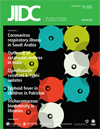Epidemiology, clinical presentation, and patterns of drug resistance of Salmonella Typhi in Karachi, Pakistan
DOI:
https://doi.org/10.3855/jidc.1967Keywords:
S. Typhi, population-based incidence, drug resistance, PakistanAbstract
Introduction: Enteric fever remains a major public health problem in Asia. Planning appropriate preventive measures such as immunization requires a clear understanding of disease burden. We conducted a community-based surveillance for Salmonella Typhi infection in children in Karachi, Pakistan.
Methodology: A de jure household census was conducted at baseline in the study setting to enumerate all individuals. A health-care facility-based passive surveillance system was used to capture episodes of fever lasting three or more 3 days in children 2 to 16 years old.
Results: A total of 7,401 blood samples were collected for microbiological confirmation, out of which 189 S. Typhi and 32 S. Paratyphi A isolates were identified with estimated annual incidences of 451/100,000 (95% CI: 446 – 457) and 76/100,000 (95% CI: 74 – 78) respectively. At the time of presentation, after adjusting for age, there was an association between the duration of fever and temperature at presentation, and being infected with multidrug-resistant S. Typhi. Of 189 isolates 83 were found to be resistant to first-line antimicrobial therapy. There was no statistically significant difference in clinical presentation of blood culture sensitive and resistant S. Typhi isolates.
Conclusion: Incidence of S. Typhi in children is high in urban squatter settlements of Karachi, Pakistan. Findings from this study identified duration of fever and temperature at the time of presentation as important symptoms associated with blood culture-confirmed typhoid fever. Preventive strategies such as immunization and improvements in water and sanitation conditions should be the focus of typhoid control in urban settlements of Pakistan.
Downloads
Published
How to Cite
Issue
Section
License
Authors who publish with this journal agree to the following terms:
- Authors retain copyright and grant the journal right of first publication with the work simultaneously licensed under a Creative Commons Attribution License that allows others to share the work with an acknowledgement of the work's authorship and initial publication in this journal.
- Authors are able to enter into separate, additional contractual arrangements for the non-exclusive distribution of the journal's published version of the work (e.g., post it to an institutional repository or publish it in a book), with an acknowledgement of its initial publication in this journal.
- Authors are permitted and encouraged to post their work online (e.g., in institutional repositories or on their website) prior to and during the submission process, as it can lead to productive exchanges, as well as earlier and greater citation of published work (See The Effect of Open Access).








